The ASUS ROG Maximus Z690 Hero Motherboard Review: A Solid Option For Alder Lake
by Gavin Bonshor on June 15, 2022 8:00 AM EST- Posted in
- Motherboards
- Intel
- Asus
- ROG
- DDR5
- PCIe 5.0
- Alder Lake
- 12th Gen Core
- Z690
- LGA1700
CPU Performance, Short Form
For our motherboard reviews, we use our short form testing method. These tests usually focus on if a motherboard is using MultiCore Turbo (the feature used to have maximum turbo on at all times, giving a frequency advantage), or if there are slight gains to be had from tweaking the firmware. We put the memory settings at the CPU manufacturers suggested frequency, making it very easy to see which motherboards have MCT enabled by default.
For Z690 we are running using Windows 10 64-bit with the 21H2 update.
Rendering - Blender 2.79b: 3D Creation Suite
A high profile rendering tool, Blender is open-source allowing for massive amounts of configurability, and is used by a number of high-profile animation studios worldwide. The organization recently released a Blender benchmark package, a couple of weeks after we had narrowed our Blender test for our new suite, however their test can take over an hour. For our results, we run one of the sub-tests in that suite through the command line - a standard ‘bmw27’ scene in CPU only mode, and measure the time to complete the render.

Rendering - Crysis CPU Render
One of the most oft used memes in computer gaming is ‘Can It Run Crysis?’. The original 2007 game, built in the Crytek engine by Crytek, was heralded as a computationally complex title for the hardware at the time and several years after, suggesting that a user needed graphics hardware from the future in order to run it. Fast forward over a decade, and the game runs fairly easily on modern GPUs, but we can also apply the same concept to pure CPU rendering – can the CPU render Crysis? Since 64 core processors entered the market, one can dream. We built a benchmark to see whether the hardware can.
For this test, we’re running Crysis’ own GPU benchmark, but in CPU render mode. This is a 2000 frame test, which we run over a series of resolutions from 800x600 up to 1920x1080. For simplicity, we provide the 1080p test here.

Rendering - Cinebench R23: link
Maxon's real-world and cross-platform Cinebench test suite has been a staple in benchmarking and rendering performance for many years. Its latest installment is the R23 version, which is based on its latest 23 code which uses updated compilers. It acts as a real-world system benchmark that incorporates common tasks and rendering workloads as opposed to less diverse benchmarks which only take measurements based on certain CPU functions. Cinebench R23 can also measure both single-threaded and multi-threaded performance.
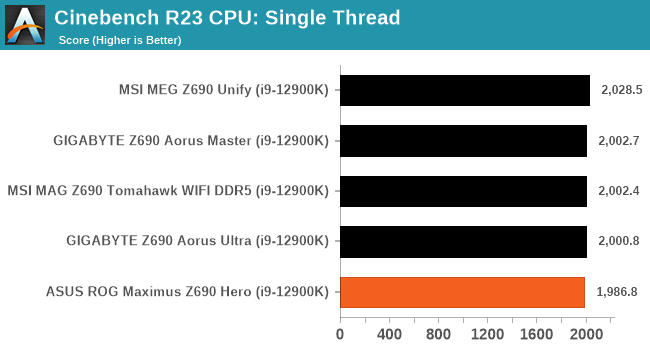
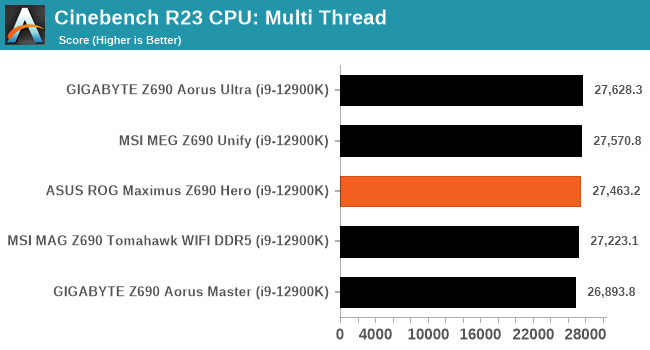
Synthetic - GeekBench 5: Link
As a common tool for cross-platform testing between mobile, PC, and Mac, GeekBench is an ultimate exercise in synthetic testing across a range of algorithms looking for peak throughput. Tests include encryption, compression, fast Fourier transform, memory operations, n-body physics, matrix operations, histogram manipulation, and HTML parsing.

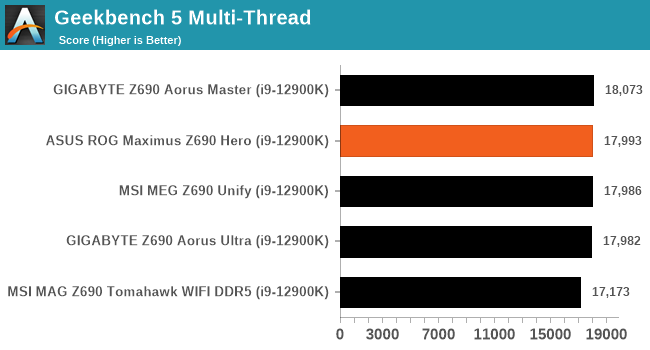
Compression – WinRAR 5.90: link
Our WinRAR test from 2013 is updated to the latest version of WinRAR at the start of 2014. We compress a set of 2867 files across 320 folders totaling 1.52 GB in size – 95% of these files are small typical website files, and the rest (90% of the size) are small 30-second 720p videos.
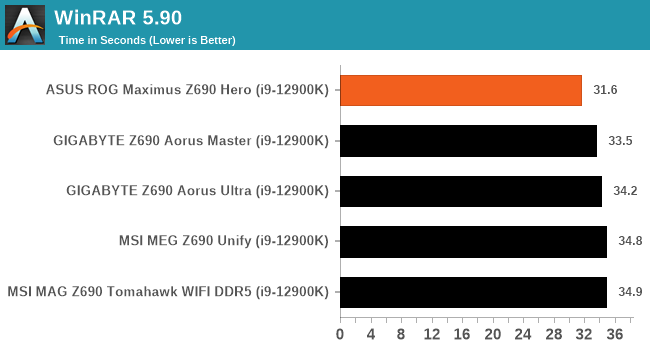
3DPMv2.1 – 3D Movement Algorithm Test: link
3DPM is a self-penned benchmark, taking basic 3D movement algorithms used in Brownian Motion simulations and testing them for speed. High floating point performance, MHz, and IPC win in the single thread version, whereas the multithread version has to handle the threads and loves more cores. For a brief explanation of the platform agnostic coding behind this benchmark, see my forum post here.

NAMD 2.13 (ApoA1): Molecular Dynamics
One frequent request over the years has been for some form of molecular dynamics simulation. Molecular dynamics forms the basis of a lot of computational biology and chemistry when modeling specific molecules, enabling researchers to find low energy configurations or potential active binding sites, especially when looking at larger proteins. We’re using the NAMD software here, or Nanoscale Molecular Dynamics, often cited for its parallel efficiency. Unfortunately the version we’re using is limited to 64 threads on Windows, but we can still use it to analyze our processors. We’re simulating the ApoA1 protein for 10 minutes, and reporting back the ‘nanoseconds per day’ that our processor can simulate. Molecular dynamics is so complex that yes, you can spend a day simply calculating a nanosecond of molecular movement.
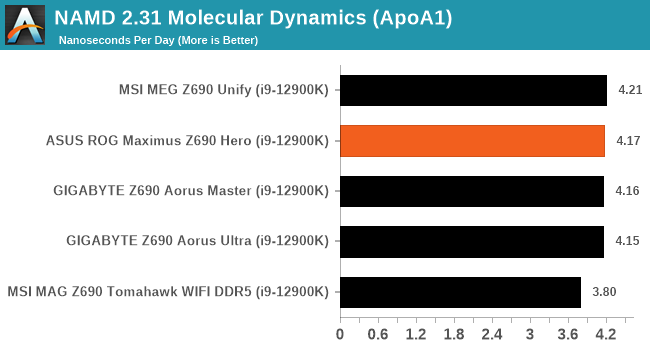











40 Comments
View All Comments
shabby - Thursday, June 16, 2022 - link
I'll bet there will be an intel gpu review though...erotomania - Thursday, June 16, 2022 - link
Intel GPU review before an Nvidia 3000 review?No Starfighter doesn't count!
shabby - Thursday, June 16, 2022 - link
Sponsored review, you can count on it.PlextorPro - Thursday, June 16, 2022 - link
Intel GPU.........WHAT???You sound like a real enthusiast.....NOT!
mode_13h - Thursday, June 23, 2022 - link
> #1 GPU review site on earth foreverThere have long been sites with comparable or even more comprehensive benchmarks, but the Deep Dives are what really set Anandtech apart.
I hope someone is going to cover Hot Chips, this year. Can't they at least find some grad student or post doc who's going anyway to just liveblog about it?
Byte - Sunday, July 17, 2022 - link
In all honestly all Nvidia does is enable another core complex and add 5% performance and charge 25% more.bug77 - Thursday, June 16, 2022 - link
I haven't read the review yet, but when the best you can say about a $600 board is that it's "a solid option", you know the board is a dud.PeachNCream - Thursday, June 16, 2022 - link
$600 huh? There must be a market for these moron-tier products, but it really would be nice if Anandtech reviewed something relevant to its dwindling community instead of just accepting whatever the OEMs dump onto them out of desperation to drum up hype and sales for fringe products almost none of us are interested in purchasing. Then again, who am I kidding? AT has had this sort of disconnect for quite a few years now.PlextorPro - Thursday, June 16, 2022 - link
Seriously, thank you for this review and in-depth evaluation!With the recent increase in popularity of MINI-ITX (SFF) systems, I would like to see an in-depth! review-comparison of the ASUS ROG Strix Z690-I with other MINI-ITX main boards. I have built a system with this MINI-ITX MB and am very pleased with the performance.
It has a custom loop for cooling both the i9 12900K and an AMD RX 6800 GPU.
PlextorPro - Thursday, June 16, 2022 - link
Seriously, thank you for this review and in-depth evaluation!With the recent increase in popularity of MINI-ITX (SFF) systems, I would like to see an in-depth review-comparison of the ASUS ROG Strix Z690-I with other MINI-ITX main boards. I have built a system with this MINI-ITX MB and am very pleased with the performance.
It has a custom loop for cooling both the i9 12900K and an AMD RX 6800 GPU.